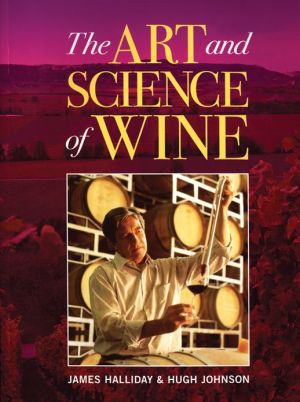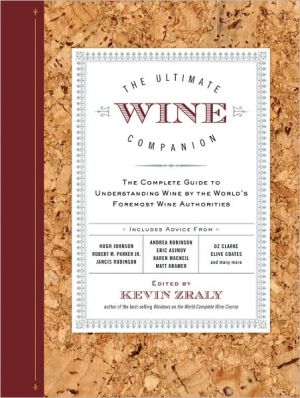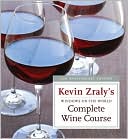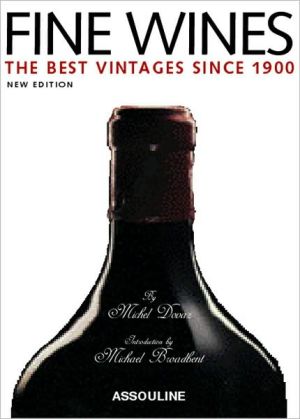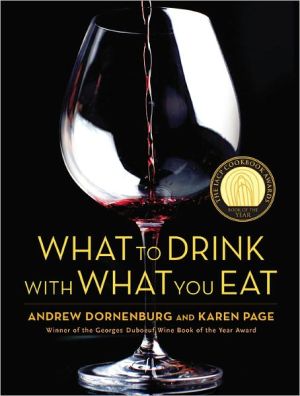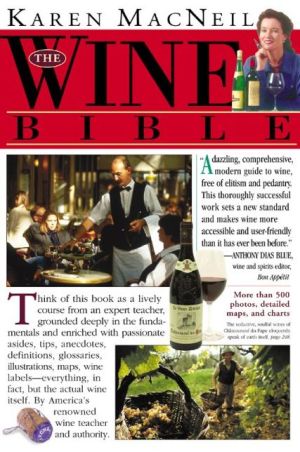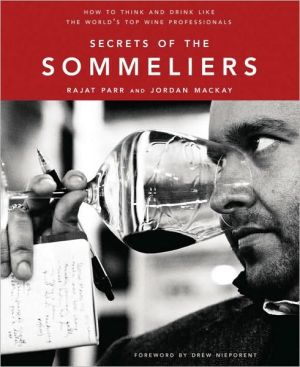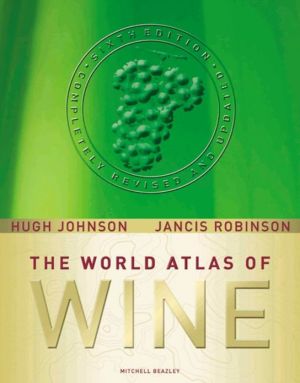The Art and Science of Wine
How wine is made, from field to cellar to bottle.\ Great wine is a complex blend of nature, art and science. In this updated new edition of a classic book, the "how and why" of a wine's creation are examined in detail.\ Acclaimed wine writers James Halliday and Hugh Johnson analyze the art and science behind the winemaking process. They start with the fundamental role of terroir the complex combination of characteristics that give a wine its personality. The latest developments in pruning and...
Search in google:
A well-illustrated updated edition of a classic on wine and winemaking. The authors look at all aspects of wine's complexity and personality: including the latest developments in growing, choices vintars make, and detail production for nine wine styles.
A Propos \ By Hugh Johnson\ The rusty cannon gives the Moutardes' yard, divided from the village street by iron railings, its faint air of a comic opera set. It was last fired in 1964, when a cloud the color of a decomposing eggplant and exactly the size of the vineyards of Muligny, hanging poised above the slopes of Chassard, the next-door commune, began to roll ominously toward the Clos du Marquis.\ Monsieur Moutarde had towed the weapon into the vineyards behind a borrowed tractor, loaded it with a canister of grapeshot of the vintage of 1815, leveled it at the heart of the threat and plucked up his courage to apply the taper. The explosion was thunderous. Nobody in Chassard was sure whether what clattered down on several roofs was a flurry of hail or straying grapeshot. The cloud rolled on, menacing but still costive, over Muligny and three more communes before suddenly dumping its gumball-size hailstones on the scruffy oak woods on the hill above Beaune.\ The oaks were shredded; not a leaf was left. But in Chassard relief for the spared vines was tempered by unneighborly feelings toward Monsieur Moutarde indeed toward Muligny as a whole. The two villages had never exchanged more than civilities; not in 2,000 years. One must not put too much weight on the cannon incident; it was merely a symbol of the rivalry that had existed since the Romans.\ Things were different then, in the early 1960s, in several ways. For a start, nobody had any money -- or if there was any cash in the mattress it meant a harvest mortgaged to a merchant in Beaune.\ The way the Moutardes made wine had changed very little since the Middle Ages. The mostevident progress lay in the vineyards, which since phylloxera had been far more uniform than before: orderly rows of grafted vines that got a good dusting of sulfur and a bright blue spray of bouillie bordelaise as often as the weather and Monsieur Moutarde's energy and resources determined.\ The vats in the cuvier were Napoleonic, the barrels in the mossy cellar dark with indeterminate age. Only the basket press on its iron wheels definitely bore some relation to the Industrial Revolution.\ Monsieur Moutarde had a little cache of bottles in a corner of the cellar; no labels, but dates written in chalk that stood up very badly to any handling. In any case he knew the positions of all the bottles, whose vintages stepped back with irregular intervals to before phylloxera and his grandfather's death. To drink one of them was exceptional. The family's daily drinking came in liters from the cave coopérative.\ In fact the Moutardes had little to do with their own wine at all. They were farmers, on a tiny scale, who picked their grapes, put them through a sort of grinder that tore off most of the stems, then piled them in a vat and waited for the heady, stinging smell of fermentation to fill the barn. Then twice a day the younger male members of the family climbed the ladder to the open top of the cuve, wearing only shorts (and sometimes not even these), gripped the edge firmly and lowered themselves in. Their combined weight was sometimes barely enough, even with a fair bit of bouncing, to break the thick raft of skins and still-whole grapes buoyed up on the surface by the fizzing fermentation below. Once you got through into the warm half-wine, the idea was to turn the fragments of raft upside down and tread them back in. This way none of the goodness, the color and flavor of the grapes, would be lost.\ Three weeks or so after harvest, with the weather distinctly chilly, the fermentation was finished; it was time to empty the contents of the vat into the barrels below, after washing them out energetically with a length of chain to scour the inside and endless cold water from the well.\ That was almost the last the Moutardes saw of their wine. Before Christmas the négociant called, tasted each barrel, told them how bad business was, and named a price. In January a truck came over, parked beside the cannon and hoisted the barrels up to take them to Beaune.\ Sometimes in good years (meteorologically and financially) Monsieur Moutarde would decide to keep a small barrel in the cellar, taste it from time to time with a neighbor, and at the end of three or four or even five years laboriously round up and wash enough bottles to hold all the dark fragrant liquid. Most of these he would distribute around the family, whose vineyard it was just as much as it was his. His own share would be chalked and squirreled away.\ Only he knew the almost celestial satisfaction that lay in the best and oldest bottles: a mingling of plums and earth and game, of heat and cool, of fungus and farmyard, of iron and leather, yet giving off, for all its strength and maleness, a scent as clear-ringing as violets.\ \ This was Burgundy 40 years ago, the most prestigious and sought-after region in the world of wine, but a world where even the rarest and finest of wines from the greatest vineyards went for a song.\ Wine-growers dragged along at subsistence level, faintly hoping that some eccentric might come and offer to buy their burdensome inheritance, yet dreading the loss of their ancient bond with the land and its sweetest fruit. Monsieur Moutarde and his generation, like their forebears, were prisoners of their peasant suspicions and superstitions. By regarding even the next commune as a rival, they spurned comparisons, they turned their backs on new ideas, and they rejected progress. But they conserved and intensified the identity of their cru. When they planted a new vine it came from their own cuttings. Every move they made at vintage time and in the cellar was ritualized. Muligny could only be made this way.\ Frequently the results of such sleepwalking were catastrophic. It was often just as well the négociant took away barrels of faulty wine to treat them as far as possible, then blend them with Rhône or Algerian, to produce an approximation the world would accept as Burgundy.\ Occasionally ritual was blessed with luck, and the results were sublime. Certainly there was enough of this elusive sublimity to keep the legend of Burgundy alive and waiting for the next generation -- and to fire the imaginations of the very few wine-lovers, mostly Americans, who aspired at least to collect, perhaps one day even to emulate, what they considered the loveliest of all wines.\ \ Monsieur Moutarde's children live in a different world. They have been to technical colleges, even to universities with departments of viticulture and oenology. They exchange views, read trade journals -- and openly compete with one another. They even see themselves as competing with other countries. Above all, the peasant instinct for secrecy has evaporated.\ The years between the 1960s and today have seen the greatest change in the making, the quality and the distribution of wine in its 8,000-year history. This is not something to be surprised at. Which art and which science has not altered almost out of recognition in the era of technology?\ Yet wine and our expectations of it are profoundly linked with age and time. Of all the food and drink we consume, only wine can live (and indeed change wonderfully for the better) for decades -- even, exceptionally, for a century or more. Yet its lifespan is never certain: its aging process is unpredictable enough to seem to wear a mantle of mystery.\ That cars should work better, or microchips have almost magical properties, are things we can accept without surprise, since they are the products of scientific inventiveness. But weren't we always told that the greatest wines are products of evolution, of tradition, of respect for the soil and patience in the cellar? How can technology improve on something that emerges from the womb of time?\ \ Perhaps we need to ask how the standards were set in the first place. Who decided that one wine was "better" than another -- or indeed that there were qualities specific to wine that varied from place to place, season to season and time to time?\ Wine was apparently discovered (or first exploited) in warm-temperate regions (the Caucasus and the warmer Middle East) before migrating, at first as merchandise, to such temperate zones as central Italy, then progressively to cooler areas in France and (coolest of all) Germany.\ While wine growing was limited to Mediterranean regions, its quality was broadly measured in terms of strength and sweetness. As it left the Mediterranean and found niches along the trade routes of central, western and northern Europe, these were presumably still the qualities that exacting drinkers looked for.\ What they found, though, in regions where the vine was more and more of a marginal crop, was a drink of a different nature altogether. Sweetness could not be taken for granted. High strength was replaced by relatively high acidity.\ This had been (and still occasionally is) the unimproved primitive style of Italian wine, made by growing vines up trees. The "improved" state was achieved by pruning the vines low in what was known as the Greek style; even by drying the grapes to concentrate their sugar.\ Using improved viticulture, that is, low-pruned vines, in cooler regions gave rise to flavors more fruity, positive, juicy, aromatic and refreshing than either old or new Mediterranean methods.\ \ How did France become the country where wine was brought to its fullest perfection? Not because it possesses any one physical characteristic that is unique. Nor is "French genius" the answer -- although no other country takes its nourishment so seriously. Simply in certain regions intensive cultivation led to the development of local strains and varieties of grape, which in turn led to a wine culture that was closely linked to local prosperity and local pride.\ Not coincidentally these regions had either high local populations or strong trading links. Demand encouraged specialization; specialization led to experience, experience to accepted -- even stereotyped -- local methods, and the stability implied by these to distinctive local styles.\ A French author wrote recently, "There are no predestined vineyards; there are only redoubts of stubborn civilization" - called Burgundy, Bordeaux, Champagne, the Moselle, the Rhône...\ This is the theory of natural selection of what were to become the world's model vineyards and their wines. Its most surprising aspect is that it all began nearly 2,000 years ago. Wine culture has had a very long time to develop its local traits; the characteristic style of each French region is the work of 70 or 80 generations.\ In modern eyes (French eyes at least) what is most important about the great vineyards is their terroir -- their combination of soil and climate. It is truer to say that this is what is most distinctive. The major factor in their foundation was not the precise characteristics of their soil. It was their strategic situation. But even where the two combine most luckily and effectively there remains a missing element to explain the ascendancy of France (and, for its white wines, Germany). Perfect terroir close to a rich and busy market could equally have been found in Italy or Spain.\ The final building block is the pattern of climate; not just as it ripens the grapes, but as it dictates the moment of harvest and influences the progress of fermentation. The farther north you go, the narrower the band of choice of when to pick the grapes. Each vintage is a struggle to achieve full ripeness before cold or wet weather sets in. Perhaps even more important, once the grapes are picked, their fermentation has the benefit (in most years) of perfect natural temperature control: the northern autumn itself.\ Without benefit of air-conditioning, of cooling coils or brine circulating in double-walled tanks, in the classic wine regions there is at least an even chance that the must will become wine at the ideal moderate, then gently falling, temperature. At higher temperatures the grape aromas boil off, yeasts become less efficient, and bacteria flourish. If the vat gets too hot the fermentation "sticks" altogether, leaving half-made wine that is fatally prone to becoming vinegar.\ These were the problems that almost all winemakers in warmer climates had to contend with until electricity came on the scene. The one chance of avoiding them was a cool, deep-cut cellar. Modern winemaking dates from the introduction of artificial temperature control, first tried tentatively in Algeria a century ago using cold water, then more methodically in Australia, but not generally available or accepted until the 1950s and 1960s.\ Until fermentation could be kept in check, there was little purpose in planting the grapes that the north had developed for low-strength table wines. Once cool fermentation was mastered, even at the price of astronomical energy costs, the door was open to making balanced, fruity and light wines in a warm climate. From that moment on the production of sweet fortified wines, the mainstay of Mediterranean-climate vineyards around the world, went into accelerating decline. Technology had claimed its place as the indispensable ally of the winemaker. It was not long before what was seized on as essential in Australia and California had gained an interested following, to say the least, in Europe - even in parts of France. Today the range of controls open to a winemaker (with the money to pay for them) is so great as to be bewildering. European winemakers are at least limited by the conventions and traditions enshrined in their systems of appellations and denominations. European governments want, and now actively encourage, their wine industries to stay within conventional bounds, to exploit their regional traditions -- above all to avoid simple varietal labeling. It is their best way of avoiding the head-to-head competition that increasingly threatens from the industries of the New World.\ But New World winemakers still start with a clean slate. It is entirely up to them what grape varieties they plant (or buy), in what regions and soils, and how they turn them into wine. The United States is preparing the ground for what may one day become an effective appellation law. Yet its viticultural areas are a very long way from controlling or even influencing winemaking decisions.\ South Africa has the most precise wine legislation of the New World. But it is still the farmer, not the government, who decides what to plant and what kind of wine to make.\ Australia and New Zealand, meanwhile, flourish in a state of oenological anarchy. Anything goes, so long as the label "tells the truth." It is a cutthroat world, chronically short of cash, but it has proved more fertile in invention, more radical in technology and overall more successful in pleasing its patrons than any other.\ This book is about the range of choices open to a winemaker at the beginning of the 21st century. It is the fruit of collaboration between a most unscientific wine-lover and a passionate critic who is also a technocrat. I don't think James Halliday will object to my describing him in this way -- so long as I also remind you that, at Coldstream Hills in the Yarra Valley, he has made some of Australia's most technically perfect wines, which just happen to be quite delicious.\ It is no coincidence at all that James is Australian. Australia's winemakers and researchers have established themselves over the past decade as the world's most innovative, least reverent, most open-minded, most iconoclastic. And their ideas are taken very seriously indeed.\ The vintage season in Europe falling in the least interesting part of an Australian winemaker's year, a number of these iconoclasts are even migrating north in September to supervise the vintage at the invitation of proprietors and cooperative cellars in Europe -- and indeed fanning out across the rest of the globe.\ I shall never forget the look on the face of a grower in southwest France (this was in the late 1980s) when he tasted the first wine made by an Australian "flying winemaker" from grapes he had delivered to the cooperative. All his life he had been accustomed to a rather hard, perfectly adequate but totally unexciting wine as the outcome of his labors. "Mais mon dieu!" he spluttered, "ca sent le fruit!" That was just what it did smell of: grapes. And he was not at all sure that wine was supposed to do anything so obvious.\ Australian wine-lovers are hard to restrain from playing a game they call "Options." The rules are simple. An undisclosed wine is served to the company. Only the president of the game (Len Evans is the most infuriatingly skillful protagonist) knows what it is. He names three countries the wine might come from. Anyone who guesses right stays in the game; the rest drop out. Subsequent questions might name three grape varieties, districts, vintages or châteaux until the wine is identified.\ "Options" might well have been the title of this book, because at each step in the making of any wine, from the choosing of the vineyard site to the opening of a mature bottle, there are choices to be made; options to be faced.\ Many of the decisions are loaded by the economics of the business. Monsieur Moutarde of Muligny was an example of a wine-grower with very few options to give him sleepless nights. But many are not: as the choices and consequences charts show, such factors as timing and temperature can make as much difference to the quality of a wine as the most costly options: stainless-steel tanks, air-conditioning, or all-new barrels.\ The most costly option of all, perhaps, is one that is faced at every stage by a winemaker who aspires to quality. It is called selection. Only by constantly downgrading any wine that is not up to the standard you set yourself can you maintain a name and a reputation.\ Where, if anywhere, do you draw the line between art and science in producing or designing any product? It is a matter of judgment. Scientific decisions are made on the basis of measurements. Nonscientific decisions are made on the basis of habit or intuition, occasionally of inspiration. Might it be true to say that the first two amount to craftsmanship, only the third to art? "Art" is a grand word to use about the making of a drink. It is justified because exceptional wines can seem to transcend mere sensual enjoyment, to demand to be appreciated on a higher plane of awareness -- for which "art" is the only appropriate word.
A Propos\ by Hugh Johnson\ IN THE VINEYARD\ The Vine\ From the historical perspective to the attitudes and practices of the 21st century\ Terroir\ Do humans matter more than the natural environment?\ Climate\ And, for that matter, weather\ Which Variety of Vine?\ The flavor starts with the grape\ Sculpting the Vine\ Too much vigor is as bad as too little\ Quantity vs. Quality?\ Or can they be compatible?\ \ Plague and Pestilence\ Enemies of the vine\ Irrigation\ A necessary evil?\ Mechanization\ Simply a question of time?\ IN THE WINERY\ Making the Wine\ Winery equipment and how to use it\ National Attitudes and Regional Characters\ Light-Bodied White Wines\ Wooded and Full-Bodied White Wines\ Sparkling Wines\ Sweet Table Wines\ Light-Bodied Red Wines\ \ Medium-Bodied Red Wines\ Full-Bodied Red Wines\ Fortified Wines\ Oak and Wine\ IN THE BOTTLE\ The Chemistry and Methods of Analysis of Wine\ The Changes of Age\ Wine Faults\ The Manipulation of Wine\ The Great Closure Debate\ Choices and consequences\ Glossary Index Acknowledgments
\ Wine Press NorthwestLoaded with information ... Read this book and you'll be guaranteed to come out of it smarter.\ — Andy Perdue\ \ \ \ \ \ California GrapevineA superb work, masterfully done.... It's a simple formula. Take two of the best wine writers of our era and let them do a thorough analysis of the science and the art that go into every decision from the vineyard to the bottle. The result---one of the best wine books of the year. Bravo! Very highly recommended.\ — Bob Fraser\ \ \ \ deantudor.comAn extremely useful book for the beginning wine student, and an 'aide memoire' for the experienced hand.... Well worth the money.\ — Deam Tudor, Wine Writer\ \ \ \ \ \ La Cucina Italiana[An] extensive reference ... Beautifully illustrated with over 200 full color images, The Art and Science of Wine is a great addition to any wine enthusiast's bookshelf.\ — Cristabelle Tumola\ \ \ \ \ \ Wine Press NorthwestLoaded with information ... Read this book and you'll be guaranteed to come out of it smarter.\ \ \ \ \ \ California GrapevineA superb work, masterfully done.... It's a simple formula. Take two of the best wine writers of our era and let them do a thorough analysis of the science and the art that go into every decision from the vineyard to the bottle. The result---one of the best wine books of the year. Bravo! Very highly recommended.\ \ \ \ \ \ deantudor.comAn extremely useful book for the beginning wine student, and an 'aide memoire' for the experienced hand.... Well worth the money.\ \ \ \ \ \ Wine EastOne of the best overviews of the winemaking process in print today.\ \ \ \ \ \ La Cucina Italiana[An] extensive reference ... Beautifully illustrated with over 200 full color images, The Art and Science of Wine is a great addition to any wine enthusiast's bookshelf.\ \ \ \ \ \ Valley Times (Pleasanton CA)This is a different kind of smart book ... rather than being about the philosophy of wine, it is about the beauty of the wine-making process.\ \ \
